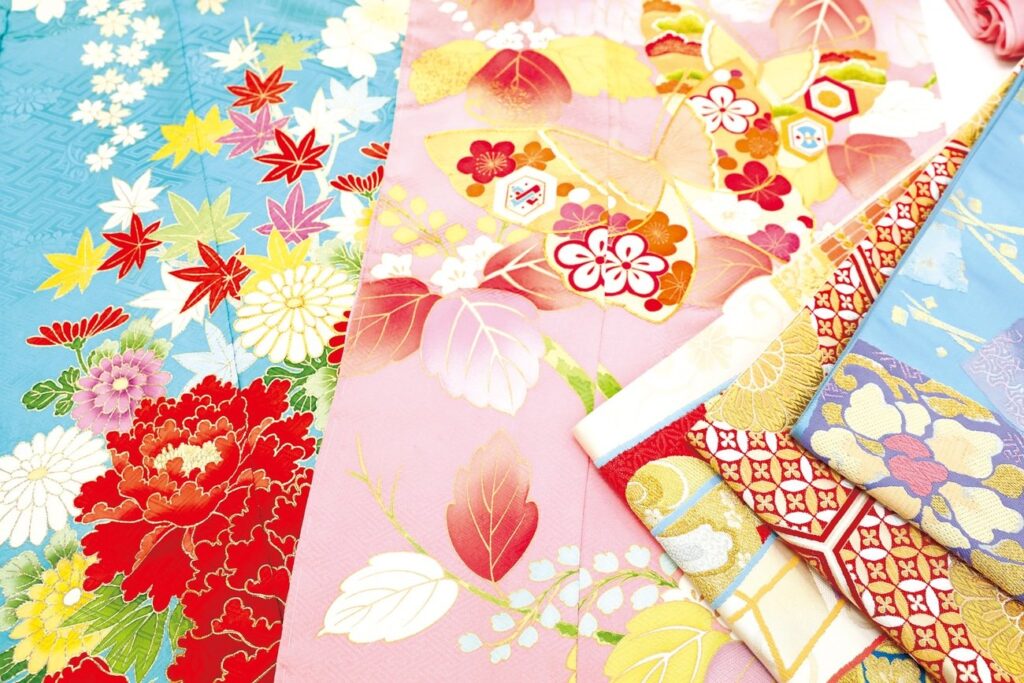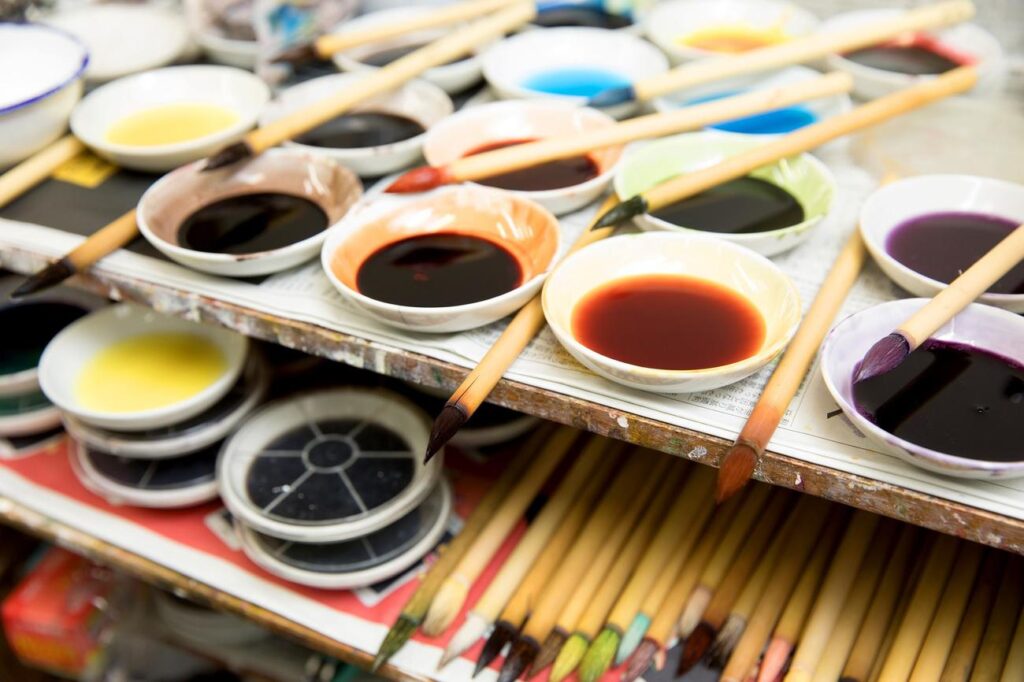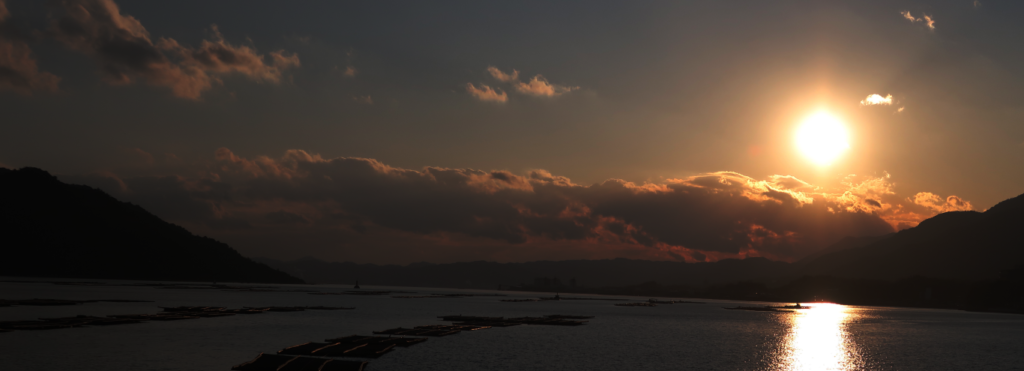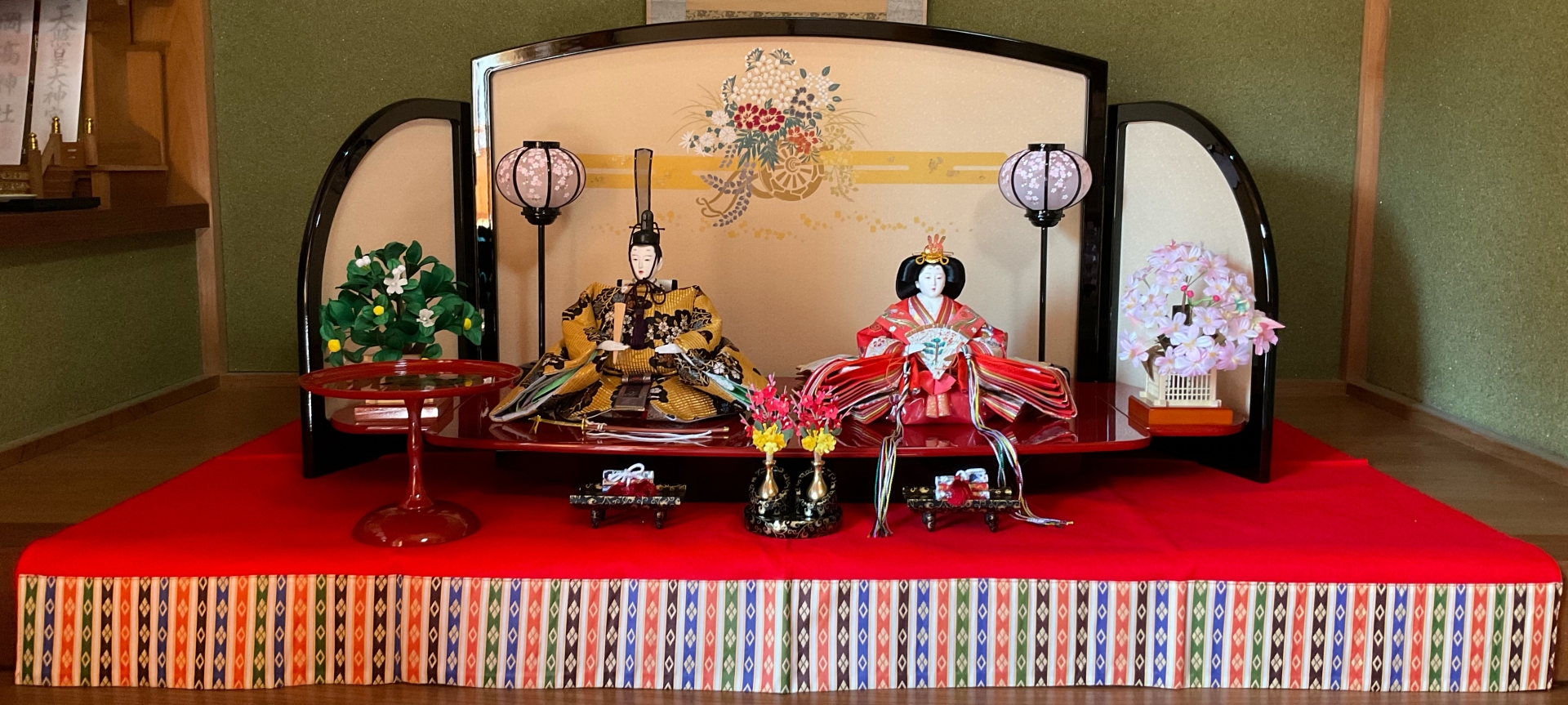1. What is Kyo Yuzen?

A kimono made by a dyeing technique called Yuzen dyeing, which was born in Kyoto.
Yuzen is a typical technique for adding patterns to dyed kimono.
In terms of dyeing techniques, until the development of Yuzen dyeing, there was only a limited method of dyeing cloth with embroidery, pasting foil, tie-dyeing, and embroidery.
Such a method was like spoiling the texture of the silk fabric.
However, with the birth of Kyoyuzen, dyeing technology has greatly evolved.
“Kyo Yuzen”, “Kaga Yuzen” and “Tokyo Yuzen” are known as Japan’s three major Yuzen.
“Kaga Yuzen” is a Yuzen dyeing dyed in Kanazawa City, Ishikawa Prefecture, and is characterized by its pictorial and realistic “flower pattern”.
In addition, it is also characterized by the fact that it is not decorated or embroidered with gold and silver foil, and no techniques other than dyeing are used.
“Tokyo Yuzen” is also called “Edo Yuzen” and is Yuzen dyeing born in Edo.
The culture of the townspeople of Edo at that time is strongly reflected, and it can be said that it is characterized by its astringent and calm colors.
It is unique to Tokyo Yuzen that it has a stylish and urban flair in a calm atmosphere.
Unlike the division of labor, Kyo Yuzen, one craftsman works consistently from composition to finishing.
Kyo Yuzen is the oldest of the three major Yuzen.
In addition, it is actively embroidered and gold and silver foil is applied, and it is the most gorgeous design among the three major Yuzen, which is a design preferred by public houses and daimyo at that time.
History
It is said that it began with dyeing a kimono with a novel pattern drawn by Miyazaki Yuzensai, who was active in Kyoto as a fan painter in the early Edo period.
As a historical background, the Shogunate issued a ban on luxury goods, and in kimono, the squint squeezing was targeted for crackdown.
For dyeing craftsmen who were in trouble because the production of Kanoko Shibori was banned and women who were looking forward to wearing gorgeous kimono, it is difficult to develop Yuzen dyeing, which is luxurious but not subject to the sumptuary law. It was a breakthrough.
This is said to be the beginning of Kyo Yuzen.
In addition, the support of such a historical background and the matching with the collection culture at that time made it a great opportunity to become popular.
With the introduction of chemical dyes from Europe in the Meiji era, “copy Yuzen” has newly emerged.
A bright and many-colored chemical dye was used, and it was developed at that time as a technique that can be dyed in large quantities at once using a paper pattern for the previous “hand-painted Yuzen”.
This is what is now called “Kata Yuzen”.
This made it possible to produce a lot and spread it to more people.
2. Work process

① Planning and devising(企画立案)
In order to create a beautiful Kyo Yuzen, it is necessary to concretely express the image that the dyers have drawn in their heads.
To that end, we will devise a design design by considering the arrangement and balance of patterns and colors based on all kinds of materials such as arts and crafts.
Then choose the right fabric for the outfit and the week.
② Yunoshi(ゆのし)
Stretch the dough with steam to adjust the length and width of the dough.
Yunoshi is performed three times in the middle of the process: lowering, middle, and raising, but it not only smoothes out the wrinkles of the fabric, but also promotes color development and gives it a luster.
③ Kenshaku・Sumiuchi(検尺・墨打:Scale and sumi)
In order to allocate each part such as the sleeves, body, and skirt of the kimono, measure the length of each and mark the fabric with ink.
④ Kariebajitate(Sitaeba)(仮絵羽仕立て(下絵羽):Temporary picture feather tailoring (lower picture feather))
By sewing in the shape of a kimono, the pattern is sewn according to the dimensions so that the pattern does not shift at the seams when dyed.
⑤ Shitae(下絵:Sketch)
Based on the design design, we will draw a pattern with blue and white liquor on the white cloth that has been temporarily painted.
Start with a pale blue flower, draw an outline, and gradually darken it to get closer to an accurate pattern.
※When the sketch is finished, untie the temporary feathers, divide them into parts, stretch the dough with bamboo stretchers so that the pattern is not distorted, and then perform the next glue placement.
⑥ Norioki(Gomu itome)(糊置(ゴム糸目):Glue (rubber thread))
Place the thread glue along the thousand two in the sketch.
This has the function of resist dyeing so that the dye does not bleed elsewhere during Yuzen.
⑦ Fushi nori(伏糊:Fushi glue)
After chewing with thread glue, place the glue evenly on the part of the pattern to be used for Yuzen, and sprinkle the powder on it.
This works as a resist dye so that the pattern part is not dyed when dyeing.
⑧Hiki zome(Jizome)(引染(地染め):Dyeing (ground dyeing))
T rial dye with another piece of cloth, and dye the color-matched dye with a brush so that there is no unevenness.
Dark colors are dyed 2 = 3 times.
⑨ Mushi(蒸し:Steamed)
Put the dyed dough in a steaming box and steam it with steam at about 100 ° C for 20 to 50 minutes to fix the ground color.
Repeat for dark backgrounds over and over again.
⑩ Mizumoto(Mizuarai)(水元(水洗い):Mizumoto (washing with water))
Rinse the steamed dough clean with plenty of good quality water.
This works to wash away excess dye and glue.
⑪ Sasdi Yuzen(挿友禅)
Using various brushes and brushes, I will insert the color in the pattern where the thread is resist dyed.
We will proceed from light to dark in order, but depending on how you handle the brush, you can also dye blur patterns.
※After Yuzen, steaming, volatile water washing, Mizumoto, and Yunoshi (middle sushi) are performed before the final processing.
⑫ Kinsai(金彩)
Use gold and silver foil and powder to create a luxurious atmosphere.
We express the beauty unique to Kyoto Yuzen with techniques such as gold knitting, pressed foil, geumbak, and sand.
⑬ Shishu(刺繍:Embroidery)
Using silk thread, gold thread, and silver thread, embroidery techniques such as piece use, suga, sagara, wrapping, and flat embroidery give the pattern a sense of elegance, gorgeousness, and volume.
Finish in a beautiful kimono suitable for Kyo Yuzen.
⑭ Karieba jitate(Ageeba)(仮絵羽仕立て(上げ絵羽):Temporary picture feather tailoring (raised picture feather))
Temporary picture feather tailoring (raised picture feather)
When all the processing is completed, it is completed by simmering (raising) and repairing the ground.
Then sew according to the measurement.
This sewn object is called a raised picture feather.
The beautiful Kyo Yuzen is completed.
3. Traditional craftsman

Takeko Okayama: Yuzenshi
The first female traditional craftsman in Kyo Yuzen.
In addition, for the first time she was certified as a traditional craftsman by Kozo Okayama and her husband and wife.
She was born in 1943 in Nihonbashi, Tokyo.
She was fascinated by the beauty of Kiyomizu ware and she went to Kyoto.
In 1958, she entered the pottery department at Higashiyama Gojozaka Kiyomizu ware and engaged in pottery painting at Osawa Kobo.
In 1964, she was attracted to Kyo Yuzen and she taught herself the path of dyeing and weaving.
In 1982, she won the Kyoto Governor’s Award at the Kyoto Yuzen Competition.
In March 1994, she was certified as a traditional craftsman.
She was very well received when she exhibited at the “Paris Collection” in France.
She was selected as a writer for the 400th anniversary of the exchange between Japan and the Netherlands, and she holds a kimono show “Japanese clothing” in Miderburg, the Netherlands. She is also active in spreading the word not only in Japan but also abroad.
For more than 60 years, she has created her own world while raising many disciples, and her soft colors have earned her a reputation as a dream kimono and have been awarded in various fields.
4. Initiatives

She is one of the efforts of “Marumasu Nishimuraya”, the Kyo Yuzen experience.
She can enjoy listening to stories and seeing her works, but I think her best learning is to experience herself.
There is a course where you can make your own original items by choosing what you want to make, the pattern you want to dye, and the color you want to rub in.
“Introduction course”
・ 1 to 1.5 hours
・ From 1,300 yen


“Authentic course”
・ 3-5 hours
・ From 8,500 yen


“Yukata / Aloha Creative Course”
・ 3 days
・ From 21,000 yen


There are several hands-on courses such as “Furoshiki wrapping experience” and “Chopsticks & Kyo Yuzen chopsticks case making course”.
If you contact me, I would like to guide you when you come to Japan!
5. Impressions

Kyo Yuzen is one of the traditional crafts that Japan is proud of in the world.
It is a very colorful work that makes you want to say that everyone who sees it is gorgeous.
It can take a month to complete all the steps, he says.
It is Kyo Yuzen that has made each process a division of labor to improve efficiency, and you can see that it has overcome the past era flexibly.
Above all, there are more traditional craftsmen than other traditional crafts.
For this reason, it is one of the excellent industries that continues to meet not only the needs of customers but also the needs of craftsmen.
Some traditional industries are still in danger of declining, while others are still evolving.
However, what can be said about any traditional craftsman is that only those who are proud of their work and want to improve further.
It is said that the old craftsmen had more advanced techniques that the current craftsmen did not have.
I think that the true inheritance of traditional crafts is to pursue it and go beyond it.
Next time preview
Thank you for reading to the end!
I would also like to post some interesting things about Kansai.
Then, have a good trip from now on!
PS. We provide various information about Kansai in Japan, so please feel free to contact us if you would like to visit or experience it!
The content of the homepage is limited to Nara Prefecture, but if there is a place you would like to visit in the Kansai area, please contact us and we will guide you!!



コメント